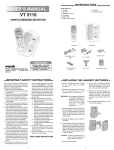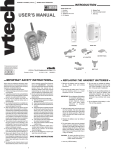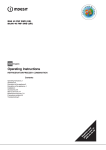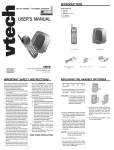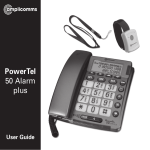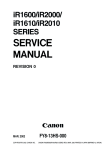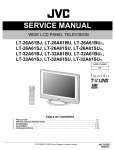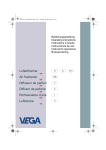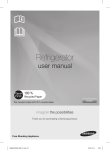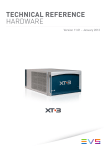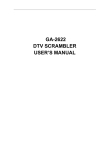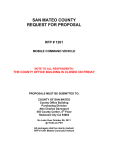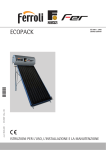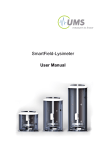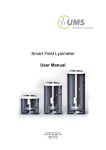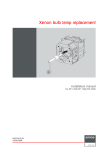Download DISHWASHER SERVICE MANUAL
Transcript
DISHWASHER SERVICE MANUAL INDEX page Tecnical features and security systems 1 Electrical components 2 Energy Label 8 Name Plate 9 Service mode 10 Failure Codes 11 Adjusting the water hardness 15 Disassembly 18 Repair Techniques 53 Tecnical Features Security Systems • Flowmeter: The amount of water intake is in precise control. • Heater safety protection: In case of lack of water, with the help of a pressure switch, the resistance is prevented from being in operation. So both the resistance and the machine itself are protected. • Overflow and Leakage Protection: The dishwasher enters overflow mode when there is too much water in the dishwasher, the excess water gets drained. (a floater rises upwards and senses when overflow water gets there) It also detects leaks in the base of the dishwasher, shuts down operation and automatically pumps out water before contact with floor. Resettable overflow 1 Electrical Components Button ( On / Off Switch ) Buton is assembled in the control panel unit. On / Off ( two pole ) Voltage Currency 250 V 16 ( 4 ) A Door Lock It is a mechanical lock/release system that is closing the door, supplying the connection of electrical parts in the machine and cutting off the connection. Currency 16 (4) A Circulation Pump Voltage Frequency Total Power Coil İsolation Class Main(First) Coil Ω Sub(second) Coil Ω Thermal Protector Pump Outlet Pressure Pump Flowrate 220/240 V 50 Hz 88 W F 95%± 7 Ω 126%± 7 Ω 109 °C 300 mbar 60 lt/min Single direction, single phase, asynchronous and two pole. It turns opposite clock direction. It is assembled to the basement with rubber hangers. 2 Capacitor 2,5 µ F – 450 V class P2 Capacitor is permanently connected to the circulation pump coils. Drain Pump Voltage Frequency Total Power Flowrate Coil Resistance Coil İsolation Class Thermal Protection 220/240 Volt 50 Hz 30 W 17 – 21 lt/min 143 Ω %± 7 F 120 ° C Heater Casing Group • Heater Voltage Total Power Resistance 220/240 V 2000 W 23.19 Ω ± ٪5 It is used to heat the washing water. Heater is not active during the drying process. It is assembled to the sump and located to the Supply side of circulation pump. 3 NTC with Thermal Protector Thermal Protection 83±3 ° C Temperatures 25°- 5000Ω 35°- 3300Ω 55°- 1520Ω 63°- 1174Ω 80°- 670Ω 90°- 488Ω %±5.0 %±5.5 %±6.5 %±7.5 %±8.0 %±8.5 NTC is assembled on the heater Casing Group. • Pressure Switch Voltage Frequency 16 A – 3 Pins • 220/240 V 50 Hz Diverter There is diverter at C31 and C41 models It is assembled to the heater Casing Group. Voltage Frequency Power Resistance 220/240 V 50 Hz 8W 6840±٪5 Ω 2 Washing Position 1.Position 2.Position Upper spray arm complete Lower spray arm complete 4 Water Inlet Valve Single inlet and single outlet standard single coil selenoid valve. Voltage Frequency Total Power Flowrate Coil İsolation Class Resistance 220/240 Volt 50-60 Hz 6W 2.5 lt/min F 3750±٪10 Ω ( 20 Cº ) It is assembled to the basement and connect to the airbreak by hose. Regeneration Valve Voltage Frequency Total Power Resistance 220/240 V 50/60 Hz 6W 4130±٪10 Ω ( 25 Cº ) Regeneration valve is assembled on the water softener. Parasite Filter 220/240 V Voltage Frequency 50/60 Hz 0,1 uF (X1) + 2x0,027uF(Y2) + 1M Ω It is used to prevent parasites from the main supply. It has been assemblied to basement. Turbo Fan Motor There is a thermal protector.Shaded pole motor , two pole temperature is between -40–150 Cº . There is Turbo Fan Motor only at C4 models. 5 Salt Sensor Voltage Currency 250 V 50 mA It is assembled to the water softener. It warns if the salt is less than requested quantity. Power Cord Type İsolation Plug Length 2 Euro 3’lü 1 mm , copper conducting TS 9760 H05VV-F TS-IEC 60884–1 PVC injected 1800 mm Drain Hose Drain hose maximum height Drain hose minimum height Drain hose maximum length 110cm 50cm 400cm 15 W Total Power Voltage Frequency Resistance 220/240 V 50 Hz. 238.6± ٪ 5 Ω Coil isolation class: H 6 Detergent / Rinse Aid Dispanser Detergant dispenser consists of rinse aid and detergant compartment. It has been assemblied to the inner door by the snap fits. Only one bobbin has been used for operating the system. 1 2 3 Detergant compartment Main wash compartment (3) Prewash compartment (2) 40 cm³ 5 cm³ Rinse aid compartment (1) : Dosage Quantities: Level Level 1 Level 2 Level 3 Level 4 Level 5 Level 6 Rinse aid dosage amount 1 cc ± 0,5 cc 2 cc ± 0,5 cc 3 cc ± 20% 4 cc ± 20% 5 cc ± 20% 6 cc ± 20% Rinse aid compartmnet: 150 cm³ Factory outlet setting position: level 3 Water Softener Resin Quantity Capacity of salt compartment Total hardness adjustment level Water Level Level 1 Level 2 Level 3 Level 4 Level 5 Level 6 Hardness 0,6lt 2kg 6 German Hardness °dH French hardness °dF Bristish hardness °dE Water Liter 0-5 0-9 0-6 - 6-11 10-20 7-14 160lt 12-17 21-30 15-21 89lt 18-22 31-40 22-28 59lt 23-31 41-55 29-39 46lt 32-50 56-90 40-63 16lt 7 Energy Label ENERGY LABEL LOGO :XXXXXX MODEL:XXXXXX ENEGY PERFORMANCE A ENERGY CONSUMPTION A ---- 1,05 kWh / cycle B ---- 1,20 kWh / cycle WASHING PERFORMANCE A,B DRYING PERFORMANCE A,B CAPACITY Standard place settings 12 persons WATER CONSUMPTION 13 – 15 lt 8 Name Plate 9 Service Mode : Starting the service test 1-Move the programme selector knob to the first program and press the start/pause button while your machine is not in operation 2-Keep the start/pause button pressed down meanwhile energise the machine by pressing the On/Off button 3-Keep start/pause button pressed until flow indicators are on and off Flow Indicator Start/pause button button Picture 1 4- Move the programme selector knob to the reset position Keep the start/pause button pressed until program monitor lights are on and off. Picture 2 After finalizing the above processes; the service program starts automaticly. Program algrorithm steps follow each other automatically. In case of a problem; the program stops on STEP PROCESS TIME CONTROL 0 Show the last failure occured before ~6 sec At the beginning of service program 1 Drain ~4 sec Drain pump is running 2 Fill (~3,5lt) 3 wash 4 Wash + Heating 5 Regeneration ~1 min Regeneration value 6 Drain ~20 sec Drain Pump 7 End led highlight ~1min 25 sec ~1min 10 sec ~5 min Water inlet valve and flowmeter is controlled. (At 2,5lt circulation pump starts to run) Circulation pump – detergant dispenser Heater Casing (pressure switch)- NTC- diverter positions the problem step and show failure code. You can understand the problem by looking the failure code. 10 Failure Codes : C1 Models Wash ERROR CODE End Start /Pause ERROR DESCRIPTION POSSİBLE PROBLEMS • Inadequate water supply • • • • • • • • Error of continuous water input The waste water in the machine cannot be discharged. Circulation pump can be out of order or have a problem with the cable connection. • Electronic card can be out of order. • Water inlet valve can be out of order or can not be closed. • Electronic card can be out of order. • • • Water outlet hose is clogged. Water discharge hose can be out of order. There can be a problem with cable connection of the drain pump. Pressure switch of the heater casing group can have a mechanical or cable connection problem. • Intended water temperature could not be reached/ faulty heater and/or heater sensor Make sure the water input tap is totally open and that there is no water cut. Close the water input tap, separate the water input hose from the tap and clean the filter at the connection end of the hose. .Water inlet valve filter can be Water inlet valve can be out of order There can be a problem with the cable connection of water inlet valve. Floater switch can be out of order or have a problem with the cable connection. Pressure switch of the heater casing group can have a mechanical or cable connection problem. • Electronic card can be out of order. • • NTC can be out of order. Faulty NTC cable connection can be faulty. NTCshort or open circuit. Thermal protection can be out of order. Heater can be out of order or cable connection can be out order. • • • • There can be a water leakage from the tub. Floater switch can be out of order or have a problem with the cable connection. • Electronic card can be out of order. • By the Immediate and continuous voltage decreases software variants can not be kept in the memory of electronic card. Faulty Flowmeter • • Cable connection of flowmeter can be faulty. Electronic card can be out of order. Door is open • • Door lock mechanism can be out order. There can be o problem with the cable connection of door lock. Electronic card can be out of order. Alarm is active against water overflow Electronic card parameter faulty • 11 Failure Codes: C2 – C3 – C4 Models ERROR DESCRIPTION ERROR CODE DISPLAY WASH RINSE DRY END CONTROL START/PAUSE • • • • • Inadequate water supply • • F5 • • Error of continuous water input F3 • • • • • F2 The waste water in the machine cannot be discharged. • • 12 Make sure the water input tap is totally open and that there is no water cut. Close the water input tap, separate the water input hose from the tap and clean the filter at the connection end of the hose. .Water inlet valve filter can be Water inlet valve can be out of order There can be a problem with the cable connection of water inlet valve. Floater switch can be out of order or have a problem with the cable connection. Pressure switch of the heater casing group can have a mechanical or cable connection problem. Circulation pump can be out of order or have a problem with the cable connection. Electronic card can be out of order. Water inlet valve can be out of order or can not be closed. Electronic card can be out of order. Water outlet hose is clogged. Water discharge hose can be out of order. There can be a problem with cable connection of the drain pump. Pressure switch of the heater casing group can have a mechanical or cable connection problem. Electronic card can be out of order. ERROR CODE DISPLAY WASH RINSE DRY ERROR DESCRIPTION END CONTROL START/PAUSE • • • F8 Heater Error: Inadequate heat Alarm is active against water overflow F1 Alarm is active against water leakage F7 Exceed heating problem (water inside the machine is too high) • NTC can be out of order. Faulty NTC cable connection can be faulty. NTCshort or open circuit. Thermal protection can be out of order. Heater can be out of order or cable connection can be out order. • Floater switch can be out of order or have a problem with the cable connection. • Electronic card can be out of order. • There can be a water leakage from the tub. • Floater switch can be out of order or have a problem with the cable connection. • Electronic card can be out of order. • water inside the machine is >77°C, NTC can be out of order. Electronic card can be out of order. • • • • F9 Diverter position problem 13 • Diverter electric contacts can have open circuit Cable connection of tghe diverter can be faulty Electronic card can be out of order. ERROR DESCRIPTION ERROR CODE DISPLAY WASH RINSE DRY END CONTROL START/PAUSE • • F6 FE NTC faulty • • By the Immediate and continuous voltage decreases software variants can not be kept in the memory of electronic card • Water Hardness is not be adjusted or Water Hardness adjustment can not be kept in the elctronic card memory. Water Hardness shoul be adjusted by controlling the supply water. Electronic card parameter faulty • SE Electronic card water hardness faulty • • F4 FA NTC can be out of order. Faulty NTC cable connection can be faulty. NTCshort or open circuit. Electronic card can be out of order. Cable connection of flowmeter can be faulty. Electronic card can be out of order. Faulty Flowmeter Faulty turbidity sensor • • • • • • • Door is open 14 Kirlilik sensörü kablo bağlantısı hatalı Turbidity sensor can be out of order. There can be some soil around the turbidity sensor. Electronic card can be out of order. Door lock mechanism can be out order. There can be o problem with the cable connection of door lock. Electronic card can be out of order. ADJUSTING THE WATER HARDNESS First of all be sure that the machine isn’t in operation 1- Move the programme selector knob to the 0 (Reset) position while your machine is not in operation. 2- After this operation press the Start/Pause button and keep it pressed down 3- Meanwhile, energise the machine by pressing the Power On/Off button 4- Keep the start/pause button pressed until the flow indicators are on and off. It takes ~5" - Your machine displays the latest entered water hardness setting. Water hardness can be adjusted by pressing start/pause button according to Table of Water Hardness Level Settings. - After adjusting the water hardness level , press on/off button to save settings in memory. 15 Model : C1 Models C2 – C3 Water Hardness Level German Hardness dH French Hardness dF British Hardness dE Water Hardness Level Indicator 1 0-5 0-9 0-6 2 6-11 10-20 7-14 3 12-17 21-30 15-21 4 18-22 31-40 22-28 End light (12h) is open. 5 23-31 41-55 29-39 Wash and end light (3h+12h) is open. 6 32-50 56-90 40-63 Rinse and end light (6h+12h) is open. Wash light (3h) is open. Rinse light (6h) is open. Dry light (9h) is open. 16 Model C4 Water hardness can be adjusted by pressing “+” and “-“ on display. 3 according to Table of Water Hardness Level Settings. Water hardness level German hardness dH French hardness dF British hardness dE Hardness Level Indicator 1 0-5 0-9 0-6 L1 is seen on display. 2 6-11 10-20 7-14 L2 is seen on display. 3 12-17 21-30 15-21 L3 is seen on display. 4 18-22 31-40 22-28 L4 is seen on display. 5 23-31 41-55 29-39 L5 is seen on display. 6 32-50 56-90 40-63 L6 is seen on display. 17 DISASSEMBLY 1 ) ACCESSIBILITY 1.1) Top Plate a) Remove two screws that fix the top plate at the back. b) Push the top-plate back and pull it up. 18 1.2 ) Front Panel a) Remove six screws that fix the .front panel. b).Pull down the front panel as it shown in the Picture. 19 Front panel Remove six screws that fix the.front panel. 1.3 ) Plastic Kick plate a) Remove two screws fixing plastic kick plate. b) Remove the plastic kick plate as it is shown in the picture. 1.4 ) Side panels Before removing side panels ; a) Firstly remove the top plate. ( see1.1 ) b) Than remove plastic kick plate. (see1.3 ) 20 While removing side panels ; a) Remove six screws that fix side panels at the back. b) Remove four screw covers carefully as it shown in the Picture. b) Remove six screws whice are in front of the machine. 21 22 c) To remove the side panel , remove the upper plastic hinge and than the above one and pull it up. 1.5 ) Kick Plate Sheet Iron a) Remove top plate, plastic kick plate and side panels. ( see 1.1 ,1.3 , 1.4 ) b) Remove two screws tat fix the kick plate sheet iron. c) pull it down as shown in the picture. 23 1.6 ) Control Panel a)Remove six screws that fix control panlel to the door inside sheet iron. 24 b) Remove the cable connection plastic which fix cable harness to the control panel as shown in the Picture. 14 c) Remove the conrol panel group carefully as shown in the picture. d)Remove the wires that are connected to control panel group. 25 1.6.1 ) Rotary Switch a) Remove the control panel.( see 1.6 ) b)Remove the wire that is connected to the electronic card. c) Remove two screws fixing to the control panel group. 1.6.2 ) Electronic Card a)Remove the wires that are shown in the picture. . WARNING: while removing wires , do not pull them from wires , pull from connectors. b)Remove pcb box cover with pulling its plastic hinges. 26 c) Remove the wire which is between rotary switch and electronic card. d) Remove the electronic card from pcb box by removing pcb box’s plastic hinges. 1.6.3 Display Card ( Only for C4 models ) a) Remove the wire that is between display card and electronic card. b) Remove display card from display card box’s hinge carefully. 27 1.7 )Door Lock Group a) Remove control panel group. ( see 1.6) b) Remove two screws that fix the door lock group. 1.8 ) Dispanser a) Remove the front panel ( see 1.2 ) b) Remove the wire. c) Remove dispanser from inside door‘s hinges by using slotted screwdriwer. d) Push and remove the dispanser . Warning : use work glovers otherwise İnside door iron sheet can cut your hands. 1.9 ) Door Inside a) Remove side panels. (see 1.4 ) 28 b) Remove hinge spring from hinge cord group as it is shown in the picture. d) Pull the door inside up as it is shown in the picture.. e) remove two screws that fix hinge movement sheet iron to the door inside. 29 THE INNER COMPONENTS 2. ) To Access The Components From Sides a)Right Sight b)Left Sight 2.1 Steam Condenser ( only in the models that have active or turbo drying systems ) a)Remove right panel. b)Open the door , and remove steam condenser’s nut. c) Pull steam condenser. 30 2.2 ) NTC with Thermal Protector a) Remove right side panel.(see 1.4) b) Remove the wires as it is shown in the Picture. c) Pull the pim down as it is shown in the picture. 31 00 d) Remove the NTC as it is shown in the picture. 2.3 ) Air-Break a) Remove the left side panel of the machine.. (see 1.4 ) b) open machine’s door.. c)Rotate counterclockwise air-break nut and remove it. d) Remove air –break’s connections with salt cap as it is shown in the picture.( be careful about plastic hinges ) 32 2.4 ) Hose Connection Plastic a ) Remove left side panel. ( see 1.4 ) b)By using flat tip screwdriver remove hose connection plastic’s hinge from the basement as it shown in the picture. c)push the hose connection plastic. Warning : If you do not obey instructions while disassembly of the hose connection plastic it can be broken. 33 2.5 ) Power Cord a ) Remove hose connection plastic.( see 2.3 ) e) Remove the lower cover.(see ) f) Remove the wires that is between power cord and parasite filter. e ) Remove the power cord.. 34 3. To Access The Components From İn Front Of The Machine a)Remove Plastic kick plate and .kick plate iron sheet.(see 1.3 – 1.5 ) . 3.1 ) Regeneration Valve a)Remove Plastic kick plate and .kick plate iron sheet.(see 1.3 – 1.5 ) b) Remove the wires.. c) To remove regeneration Value rotate counterclockwise and pull it as it is shown in the picture. 35 3.2) Drain Pump a)Remove Plastic kick plate and .kick plate iron sheet.(see 1.3 – 1.5 ) b) Remove the wires.. c)To remove the drain pump that fixes to the sump, rotate it in the direction of counterclockwise and pull . 36 4.To Access The Components from the Lover Cover a) Lay the appliance on the rear panel. b) Remove lower cover from the places that are shown in the picture. Torna resm kısım 37 4.1 ) Circulation Pump a) Lay the appliance on the rear panel. (see 4 ) Ground connection b) Remove the wires . Electric connection c)Remove two clamps that are shown in the Picture . ( Heater casing – circulation pump , sump – Circulation pump ) 4.2 ) Heater (Heater-Casing Group without diverter ) ( for C1 – C2 models ) a) Remove the machine’s lower cover. 38 b)Remove four screws that fix heater to the sump. c) Remove clamp that are shown in the Picture . ( Heater casing – circulation pump ,) c) Remove the wires that are shown in the picture. 4.2 ) Heater (Heater-Casing Group with diverter ) ( for C3 – C4 models ) a) Remove the machine’s lower cower. 39 b)Remove five screws that fix heater to the sump. c) Remove clamp that are shown in the Picture . (Heater casing – circulation pump) d) Remove the wires that are shown in the picture. e) Detach diverter as it is shown in the picture. 40 4.3 )Water Softener a)To remove salt cup cover, rotate it in the direction of counterclockwise. . b) To remove salt cup nut , rotate it in the direction of counterclockwise . c) Remove left side panel (see 1.4) d) detach the connections which are between water softener and air-break. e) Remove lower cover. f)Remove the hose that is between sump and salt camp. 41 4.4) Parasite Fitler a) Remove lower cover. b) Remove one screw fixing parasite filter. b) Remove wires.. c) Push parasite filter as shown in the picture.. 42 4.5 ) Floater a) Remove lower cover. (see 6 ) b) Remove two screws that fix floater as it is shown in the picture. . b)remove the two floater hoses . c)Remove the wire that is connected to the floater. 43 4.6 ) Water Inlet valve a) Remove lower cover.( see 6 ) b) Remove the wire that is connected to the water inlet valve. c) Remove the clamp that connects water inlet valve and air –break as it is shown in the picture. c) To remove water inlet valve pull it back as it is shown in the direction of Picture then release water inlet valve from the pins that is connected to . and rotate it in the direction of counterclockwise. 44 4.7 ) Draining Hose a) Remove the hose connection plastic.. ( see 4.4 ) b) Remove lower cover. ( see 6 ) c) Remove the clamp that fixes draining hose to the sump. d) Remove draining hose. 45 5 ) Basket Group 5.1 ) Lower Basket a)Open machine’s door. b) Pull the basket to yourself. wheells 5.2) Upper Basket a)Open machine’s door. b) Pull the basket to yourself. 46 c) Open Upper basket rail lock front. d) Pull the basket to yourself and remove it. 5.3 )Basket Rails 1 2 1- Upper basket rail stoper rear 2- Upper baket wheels 3- Upper basket rail lock front 3 47 6. ) The Components That Are İnside the Tub 6.1 ) Course , Micro and metal filters a)Open the door. b)Remove lower basket. c) to remove microfilter group rotate them in the direction of counterclockwise and pull them up as it is shown in the Picture. d)To remove microfilter group ( course filter and micro filter ) pull them as it is shown in the picture. e)to remove the metal filter pull it up as it shown in the picture. 48 a)To remove the basket rails, open the door and take out baskets. b) To remove basket rails release the rail from upper basket stopper rear. 49 6.2 ) Spray Arm System 1 2 3 4 5 6 7 8 9 10 11 12 13 14 Upper spray arm feding canal Upper spray arm adjustment link Upper spray arm adaptor flange Upper spray arm adaptor gasket Upper spray arm adaptor cover Upper spray arm Upper spray arm nut plastic Upper spray arm nut Upper spray arm shaft Upper spray arm Lower sparay arm Spray arm support Sump seal Sump 50 a)After removing the lower basket , pull the spray arm upwards .gripping it by the central hub. b)to remove upper spray arm adjustment link pull it trought yourself as it is shown in the picture. c) to remove upper spray feeding canal turn left it than pull it up as it is shown in the picture. 51 6.3 ) Sump a) Remove any residual water from the sump by suction so that it does not flow into the tub and the pressure switch tubes , then lay the appliance on the rear panel. b) Remove lover cover. ( see 6 ) c) From inside tub ,remove the basket and lower spray arm . d) Remove the microfilter group and metal filter . c) detach all the hoses (sump – draining hose , circulation pump – sump, sump – water softener) f)Remove the four screws that secure the tumb to the tub. g) Remove the two screws which secure the spray arm support to the sump. h) detach the drain pump and pull the sump out ,taking care not to damage the tub seal. 52 REPAIR TECHNIQUES COMPONENTS AND RESISTANCE VALUES REAL VALUES COMPONENTS ON / OFF BUTTON DOOR SWITCH (KAPI KİLİDİ) PRESSURE SWITCH DRAIN PUMP WATER INLET VALVE REGENERATION VALVE SALT SENSOR HEATER DETERGENT DISPENSER CIRCULATION PUMP 0 Ω ON COMPONENT CN2.9 – CN2.2 CN2.10 – CN2.2 NOTES ON/OFF BUTTON IS PRESSED DOOR IS CLOSE 0Ω 0Ω ∞Ω FULL FILL WATER NO WATER CN2.2 – CN2.4 143 Ω % ± 7 CN2.6 – CN 2.9 3750 Ω ± %10 (20Cº) CN2.10 – CN2.7 4130 Ω ± %10(25 Cº) CN5.1 – CN5.2 0 Ω WITHOUT SALT ∞ Ω WITH SALT 23.95±15 Ω MEASURE JUST ON THE ELECTRONIC CARD MEASURE JUST ON THE COMPONENT 1660 Ω ± %10 (25 C º) CN2.3 – CN2.9 MEASURE JUST ON THE COMPONENT Primary winding Secondary winding (FROM THE COMPONENT) 95 ±%7 Ω 126 ±% 7 Ω CN 3.2 CN 3.1 SET NTC SENSOR FAN MOTOR DIVERTER 25°- 5000Ω %±5.0 35°- 3300Ω %±5.5 55°- 1520Ω %±6.5 63°- 1174Ω %±7.5 80°- 670Ω %±8.0 90°- 488Ω %±8.5 CN 2.6 – CN 2.9 238.6 ± % 5 CN 6.1 – CN 2.9 6840 ± % 5 CN 5.3 – CN5.2 0 Ω ∞ Ω CN2.1 – CN 2.5 CN2.1 – CN 2.4 0 Ω ∞ Ω RINSE AID SENSOR FLOATER (MICROSWITCH ) 53 RINSE AID OFF RINSE AID ON MICROSWİTICH IS INACTİVE (NO WATER) MİKROSWITCH IS ACTIVE (THERE İS WATER ) MEASURING THE COMPONENTS FROM THE ELECTRONICAL CARD a) b) In order to reach the connections of the electronic card; dismantle the control panel (Picture a) and probes of the tester should be applied on to the related connectors of the electronical card; control the values according to the resistance value table. (picture b) Precaution : Always remove the plug from the power socket before touching internal components. Washing pump: From the electronical card: You can just measure the primary winding value from the electronical card. Resistance value of the primary winding must be 95 Ω on the connectors CN2.3 – CN2.9 ELECTRONİCAL CARD YELLOW PURPLE CONNECTORS CONNECTORS SHOULD BE MEASURED Above sketch show the connectors of the washing pump on the electronical card. Probes of the tester should be applied on to the related connectors. 54 From the component: Measurement of the primary windings of the washing pump ( Measurement of the secondary windings of the washing pump (white cable – blue cable) Probes of the tester should be applied on to the related connectors as shown on the pictures Drain Pump: From the electronical card: CN2.2 – CN2.4 143 Ω ± % 7 ELECTRONİCAL CARD BROWN RED CONNECTORS CONNECTORS SHOULD BE MEASURED Above sketch show the connectors of the drain pump on the electronical card. Probes of the tester should be applied on to the related connectors. 55 From the component : Probes of the tester should be applied on to the related connectors as shown on the pictures Water inlet valve: From the electronical card: CN2.6 – CN 2.9 3750 Ω ± 10 ( 20 Cº) ELECTRONİCAL CARD BLUE PURPLE CONNECTOR CONNECTORS SHOULD BE MEASURED Above sketch show the connectors of the water inlet valve on the electronical card. Probes of the tester should be applied on to the related connectors. From the components : Probes of the tester should be applied on to the related connectors as shown on the pictures 56 Heater Casing : It can’t be measured from the electronical card. 23.95±15 Ω From the component: Probes of the tester should be applied on to the related connectors as shown on the pictures Detergent dispenser : It can’t be measured from the electronical card. 1660 Ω ± 10 (25 C º) Probes of the tester should be applied on to the related connectors as shown on the pictures Regeneration valve: From the electronical card: CN2.10 – CN2.7 4130 Ω ± 10 (25 C º) ELECTRONİCAL CARD Sketch at the side show the connectors of the regeneration valve on the electronical card. Probes of the tester should be applied on to the related connectors. Sketch at the PINK . ORANGE CONNECTORS CONNECTORS SHOULD BE MEASURED 57 From the component : Probes of the tester should be applied on to the related connectors as shown on the pictures Pressure switch: From the electronical card: CN2.10 – CN2.2 ∞ Ω THERE İS WATER 0 Ω THERE ISN’T WATER ELECTRONİCAL CARD BROWN ORANGE CONNECTORS CONNECTORS SHOULD BE MEASURED Above sketch show the connectors of the pressure switch on the electronical card. Probes of the tester should be applied on to the related connectors. From the component: Probes of the tester should be applied on to the related connectors as shown on the pictures 58 NTC SENSOR: From the electronical card: 25°-5000Ω-%±5.0 35°-3300Ω-%±5.5 55°-1520Ω-%±6.5 63°-1174Ω-%±7.5 80°- 670Ω -%±8.0 90°- 488Ω -%±8.5 CN 3.1 - CN 3.2 ELECTRONİCAL CARD RED BLACK CONNECTOR CONNECTORS SHOULD BE MEASURED . Above sketch show the connectors of NTC sensor on the electronical card. Probes of the tester should be applied on to the related connectors. From the component: Probes of the tester should be applied on to the related connectors as shown on the pictures Diverter : From the electronical card : CN6.1 – CN 2.9 6840 Ω-%±5.0 EECTRONİCAL CARD Sketch at the side show the connectors of the diverter on the electronical card. Probes of the tester should be applied on to the related connectors. RED RED WHITE CONNECTOR CONNECTORS SHOULD BE MEASURED 59 From the component : Probes of the tester should be applied on to the related connectors as shown on the pictures. Salt Sensor 0 Ω There is no salt ∞ Ω There is salt. CN5.1 – CN5.2 Electronic cart RED BLACK RED connectors Sketch at the side show the connectors of the salt sensor on the electronical card. Probes of the tester should be applied on to the related connectors. CONNECTORS SHOULD BE MEASURED From the component : . Salt sensor can also be measured from the water softener when the salt sensor assemblied on the water softener. 60 ON/OFF BUTTON When the button pressed 0 Ω ( can not be measured from the electronical card) Probes of the tester should be applied on to the related connectors as shown on the pictures. DOOR SWITCH From the electronical card 0 Ω ( DOOR İS CLOSE ) CN2.9 – CN2.2 ELECTRONIC CARD PURPLE CONNECTOR BROWN KONNEKTÖR CONNECTORS SHOULD BE MEASURED Above sketch show the connectors of the door switch on the electronical card. From the component : Probes of the tester should be applied on to the related connectors. 61 FLOATER CN2.1 – CN 2.5 0 Ω CN2.1–CN2.4 ∞ Ω (KONUM 1) (KONUM 2) MİCROSWITCH IS INACTIVE (NO WATER) MİCROSWITCH IS ACTIVE (WATER ) From the component : ELEKTRONICAL CARD WHİTE BLACK CONNECTOR CONNECTORS SHOULD BE MEASURED Position 1: You can check the floater by controlling the specified value intervals. ELECTRONİCAL CARD WHİTE RED CONNECTOR CONNECTORS SHOULD BE MEASURED CONNECTORS SHOULD BE MEASURED Position 2: If failure code is occured related with the floater within control the above values; you can figure out whether leakage occurs or not. 62 FAN MOTOR From the electronical card : CN 2.6 – CN 2.9 238.6 ± % 5 RED WHITE ELECTRONICAL CARD RED CONNECTOR Sketch at the side show the connectors of the fan motor on the electronical card. Probes of the tester should be applied on to the related connectors. CONNECTORS SHOULD BE MEASURED From the component : RINSE AID SENSOR From the electronical card : There isn’t any rinse aid There is rinse aid From the component : BLACK 0 Ω ∞ Ω WHITE CN 5.2 – CN 5.3 CONNECTORS SHOULD BE MEASURED 63


































































